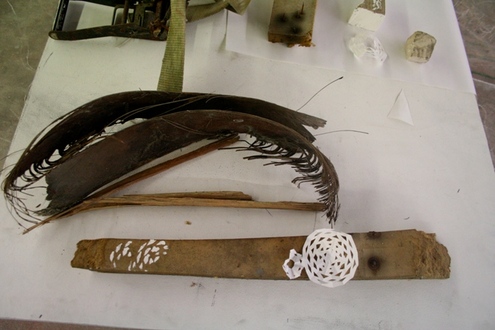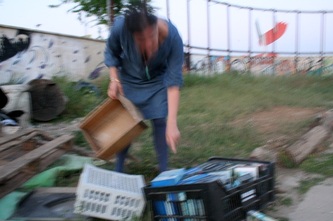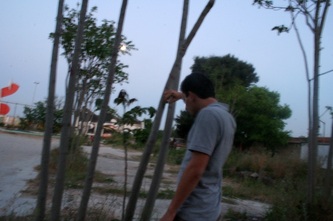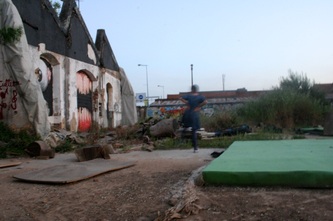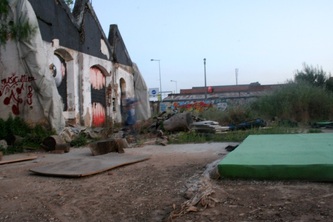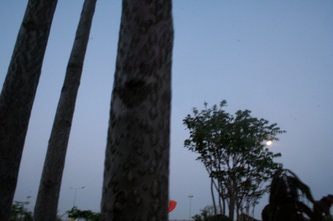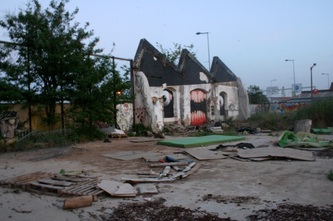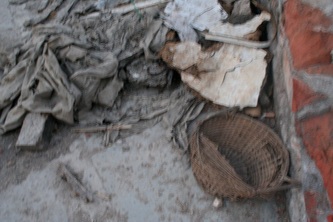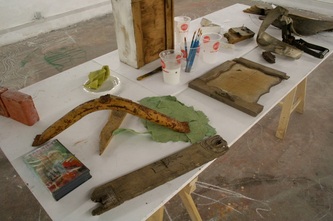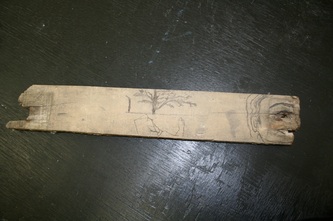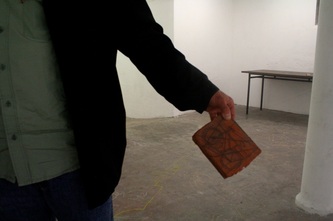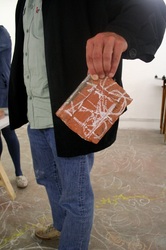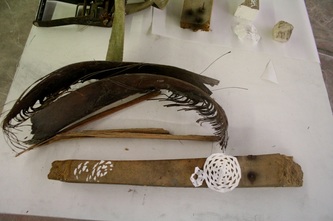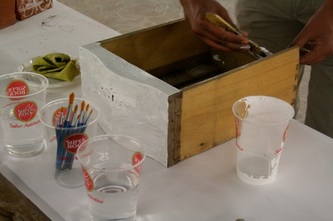_© All rigths reserved to Associação Espaços do
Desenho-Drawing Spaces. Text.Sound.Video.Images
_
Drawing on found objects
WORKSHOP Developed as a response to the project
‘It is forbidden to draw on paper!’ by pedro janeiro
(artist residency which took place at Drawing Spaces during May/April 2011
Drawing Spaces, Lisbon, Portugal
16 APRIL 2011
WORKSHOP Developed as a response to the project
‘It is forbidden to draw on paper!’ by pedro janeiro
(artist residency which took place at Drawing Spaces during May/April 2011
Drawing Spaces, Lisbon, Portugal
16 APRIL 2011
REPORT 19 -
IDEAL
Intercultural Drawing for European Adult Learning
Intercultural Drawing for European Adult Learning
WHAT
A workshop using found objects as potential supports for drawing.
WHERE
Drawing Spaces, Fábrica de Braço de Prata, Lisbon, Portugal.
WHEN
16 April 2011, 19h00-23h00
WHO
Facilitators and Staff
Pedro António Janeiro (Artist in Residence in Drawing Spaces at the time of the workshop)
Guida Casella
Ivo Covaneiro
Carla Rebelo
Pedro Gonçalves
ADULT LEARNER
13 Female and Male adults, with an age range between 19 and 35 years old.
(This workshop was open to anyone)
WHY
Pedro Janeiro’s personal research on “drawing outside the paper” was the motto for his Artistic Residency at Drawing Spaces. His personal artistic work at the point when this activity took place was based on making drawings on three-dimensional surfaces, such as his or other people’s hands or parts of the body. Hence, this activity was part of a series of 4 workshops that took place during the residency which were proposed to the public and oriented by the artist in residency and focused on drawing on ‘surfaces’ other than paper.
Drawing on found objects was set up as an activity encouraging to explore drawing in new surfaces and supports beyond paper, in terms of engaging with less familiar texture, support limits, three dimensionality and multi surfaced supports. This was also a form of stimulating drawing as an activity ‘inside the world’, through interacting and giving new meanings and expressions to objects occupying our everyday spaces and lives.
HOW
1. After providing a short description to the participants of the overall project of Drawing Spaces, Pedro Janeiro, the artist in residency, introduced his plan for the workshop in relation to his residency at Drawing Spaces.
2. The backyard outdoors of Drawing Spaces at Fábrica do Braço de Prata was the area proposed to the participants to search for objects where to draw.
3. After exploring the area, individually or in group, participants brought objects into the rooms of Drawing Spaces to respond to them as new drawing surfaces.
4. In this way, the selection of a surface for drawing became as much as a responsibility within the drawing process as the subsequent intervention on its surface/s. Some object collected by the participants:
Three branches
Mortar remains
Pieces of glass
Pieces of broken furniture
Stones
Leaves
5. Participants had to search for different materials to draw with which respond to their drawing surfaces in the most adequate or if aimed for, inadequate way: pastels, chalk, black pens, brushes and ink, graphite pencils, etc. One thing that worked particularly well with more difficult materials or textures was to apply white paint on these surfaces and draw on top of the paint afterwards, or to draw directly with white paint.
6. At the last part of the workshop, everyone gathered to look at the results of works, and participants and facilitators engaged on a final discussion about techniques, actions, effects and results, and also on the experience of drawing in found objects while exploring also drawing on less familiar surfaces, textures, dimensions, etc.
VALUE FOR LEARNERS
Participants had the opportunity to explore creatively new ways of finding new drawing surfaces out of waist and materials from their everyday lives. This also enabled them to enjoy collecting found objects and, and to find in them expressive personal value by intervening on them through drawing.
Exploring the multi-dimensionality of objects also proved to be a very unusual and enriching way to think about drawing. The interaction in group also showed to be a valuable and pleasant experience for the participants in terms of their response to the workshop.
VALUE FOR THE FACILITATORS
Facilitators gain more experience in making people feel comfortable with drawing in unconventional surfaces and ways. Through this workshop, the facilitator was also able to fully explore their role in terms of providing a good but controlled workflow, moments to pause, discussion and critique. In this particular workshop facilitators also understood the importance of providing a functional workspace, often improvising with participants, in reaction to their ways of responding to the project, and searching for, or improvising, the best drawing tools as well as being opened to creatively engage with unfamiliar materials to use them as drawing supports.
The idea of the using white paint, for example, was something that aroused during the workshop as a really good solution to explore media and materials.
VISUAL RECORDS
A workshop using found objects as potential supports for drawing.
WHERE
Drawing Spaces, Fábrica de Braço de Prata, Lisbon, Portugal.
WHEN
16 April 2011, 19h00-23h00
WHO
Facilitators and Staff
Pedro António Janeiro (Artist in Residence in Drawing Spaces at the time of the workshop)
Guida Casella
Ivo Covaneiro
Carla Rebelo
Pedro Gonçalves
ADULT LEARNER
13 Female and Male adults, with an age range between 19 and 35 years old.
(This workshop was open to anyone)
WHY
Pedro Janeiro’s personal research on “drawing outside the paper” was the motto for his Artistic Residency at Drawing Spaces. His personal artistic work at the point when this activity took place was based on making drawings on three-dimensional surfaces, such as his or other people’s hands or parts of the body. Hence, this activity was part of a series of 4 workshops that took place during the residency which were proposed to the public and oriented by the artist in residency and focused on drawing on ‘surfaces’ other than paper.
Drawing on found objects was set up as an activity encouraging to explore drawing in new surfaces and supports beyond paper, in terms of engaging with less familiar texture, support limits, three dimensionality and multi surfaced supports. This was also a form of stimulating drawing as an activity ‘inside the world’, through interacting and giving new meanings and expressions to objects occupying our everyday spaces and lives.
HOW
1. After providing a short description to the participants of the overall project of Drawing Spaces, Pedro Janeiro, the artist in residency, introduced his plan for the workshop in relation to his residency at Drawing Spaces.
2. The backyard outdoors of Drawing Spaces at Fábrica do Braço de Prata was the area proposed to the participants to search for objects where to draw.
3. After exploring the area, individually or in group, participants brought objects into the rooms of Drawing Spaces to respond to them as new drawing surfaces.
4. In this way, the selection of a surface for drawing became as much as a responsibility within the drawing process as the subsequent intervention on its surface/s. Some object collected by the participants:
Three branches
Mortar remains
Pieces of glass
Pieces of broken furniture
Stones
Leaves
5. Participants had to search for different materials to draw with which respond to their drawing surfaces in the most adequate or if aimed for, inadequate way: pastels, chalk, black pens, brushes and ink, graphite pencils, etc. One thing that worked particularly well with more difficult materials or textures was to apply white paint on these surfaces and draw on top of the paint afterwards, or to draw directly with white paint.
6. At the last part of the workshop, everyone gathered to look at the results of works, and participants and facilitators engaged on a final discussion about techniques, actions, effects and results, and also on the experience of drawing in found objects while exploring also drawing on less familiar surfaces, textures, dimensions, etc.
VALUE FOR LEARNERS
Participants had the opportunity to explore creatively new ways of finding new drawing surfaces out of waist and materials from their everyday lives. This also enabled them to enjoy collecting found objects and, and to find in them expressive personal value by intervening on them through drawing.
Exploring the multi-dimensionality of objects also proved to be a very unusual and enriching way to think about drawing. The interaction in group also showed to be a valuable and pleasant experience for the participants in terms of their response to the workshop.
VALUE FOR THE FACILITATORS
Facilitators gain more experience in making people feel comfortable with drawing in unconventional surfaces and ways. Through this workshop, the facilitator was also able to fully explore their role in terms of providing a good but controlled workflow, moments to pause, discussion and critique. In this particular workshop facilitators also understood the importance of providing a functional workspace, often improvising with participants, in reaction to their ways of responding to the project, and searching for, or improvising, the best drawing tools as well as being opened to creatively engage with unfamiliar materials to use them as drawing supports.
The idea of the using white paint, for example, was something that aroused during the workshop as a really good solution to explore media and materials.
VISUAL RECORDS
